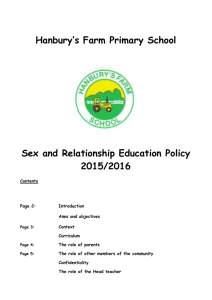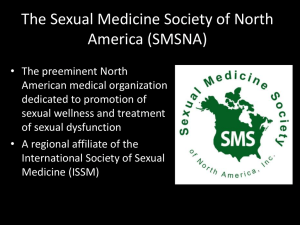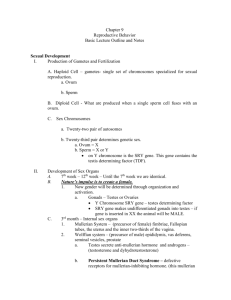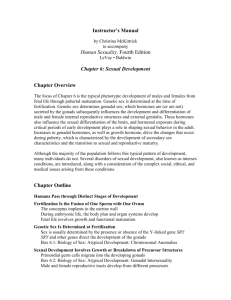PRO-PRO3-Tishelman20130244_S2-RRRR
advertisement
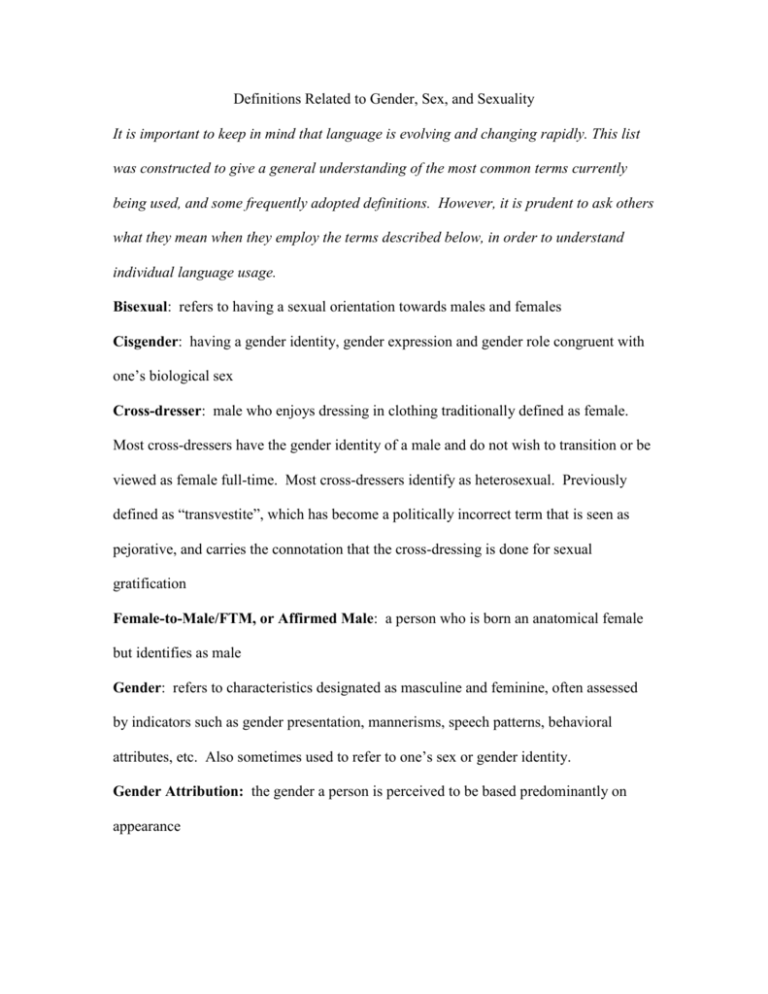
Definitions Related to Gender, Sex, and Sexuality
It is important to keep in mind that language is evolving and changing rapidly. This list
was constructed to give a general understanding of the most common terms currently
being used, and some frequently adopted definitions. However, it is prudent to ask others
what they mean when they employ the terms described below, in order to understand
individual language usage.
Bisexual: refers to having a sexual orientation towards males and females
Cisgender: having a gender identity, gender expression and gender role congruent with
one’s biological sex
Cross-dresser: male who enjoys dressing in clothing traditionally defined as female.
Most cross-dressers have the gender identity of a male and do not wish to transition or be
viewed as female full-time. Most cross-dressers identify as heterosexual. Previously
defined as “transvestite”, which has become a politically incorrect term that is seen as
pejorative, and carries the connotation that the cross-dressing is done for sexual
gratification
Female-to-Male/FTM, or Affirmed Male: a person who is born an anatomical female
but identifies as male
Gender: refers to characteristics designated as masculine and feminine, often assessed
by indicators such as gender presentation, mannerisms, speech patterns, behavioral
attributes, etc. Also sometimes used to refer to one’s sex or gender identity.
Gender Attribution: the gender a person is perceived to be based predominantly on
appearance
Gender Dysphoria (GD): current diagnosis in the DSM-5. Used as a descriptive term,
it refers to subjective mood/affect disturbance experienced by patients’ whose gender
identity is not concordant with their biological sex, and/or the gender assigned or
perceived by others. Gender dysphoria is experienced differently by different people, but
often includes feelings of anxiety, persistent discomfort that is hard to ignore, feelings of
self-consciousness, and depression.
Gender Expression: refers to how someone portrays their subjective sense of their
gender in areas as dress, speech, mannerisms, and behavior. In the
traditional/conventional paradigm gender expression is often thought of as masculine and
feminine.
Gender Identity: refers to a person’s personal sense of self as male, female or another
gender. Gender identity seems to be developed by age three and often remains stable
over one’s lifetime. However, some people experience their gender identity as fluid, and
have differing experiences of their gender or gender identity over time.
Gender Identity Disorder (GID): is the previous mental health diagnosis the DSM-IV.
Gender Role: societal expectations of how one will conduct one’s self in various areas
of life, including behaviors, attitudes, personality characteristics, gender presentation,
sexual orientation, and choice of life paths {such as type of vocation, whether one aspires
to having children, etc.} in a given culture or population
Gender Variant/Gender Non-conforming: refers to variation in gender role from
conventional norms.
Genderqueer: term that is coming into increasing use over the past several years; refers
to a gender identity that is neither completely male or completely female in a binary
paradigm, but rather refers to a gender identity that falls along a spectrum of many
genders and is described in ways such as both male and female, neither male nor female,
androgynous, androgyne, polygendered, fluid, or having no gender.
Hormone Therapy/Treatment (sometimes referred to as HRT or Hormone
Replacement Therapy): medications which stimulate development of affirmed gender
sex characteristics; some effects are not reversible
Male-to-Female/MTF, or Affirmed Female: a person who is born an anatomical male
but identifies as female
Medical Transition: Medical interventions (hormones, hormone blockers) used to alter
a person’s body to become more congruent with their gender identity
Pansexual: a relatively new term, pansexual refers to having sexual attractions to all
people, reflecting the range and fluidity of gender identity and expression, as well as
sexual orientation
Puberty Blockers (Puberty Inhibitors, Suppressors, Hormone Suppressors, GnRH
analog): medications prescribed by endocrinologists to delay or suppress puberty which
prevent development of unwanted physical sex characteristics; reversible in that a usual
pattern of puberty changes will take place if blockers are stopped
Sex: refers to biological sex, generally assigned by looking at external genitalia, and
usually with the assumption that internal genitalia, hormone levels, and chromosomes
align with the external genitalia in the conventionally accepted alignment.
Sex Reassignment Surgery (SRS, Gender Reconstructive Surgery, Gender
Confirmation Surgery, Gender Alignment Surgery, Genitoplastic surgery): Surgical
procedures which alter a person’s body to fit their affirmed gender
Sexual or Gender Minority Youth: any child or adolescent whose sexual orientation or
gender differs from the heterosexual norm or conventional gender binary.
Sexual Orientation: description of the relationship of sexual attraction between one’s
self and the sex(es) of people to whom one is erotically attracted {ex: homosexual/same
sex, heterosexual/other sex, bisexual/both sexes} Sexual orientation is often comprised
of sexual fantasy, patterns of physiological arousal, sexual behavior, personal identity and
social role. It is important to note that when using these terms one may be assuming the
sex, gender or gender identity of the other person. Heterosexual/straight and
homosexual/gay are based on viewing gender as a binary system of male and female. It
may be more accurate and informative to ask who one is attracted to, or what
genders/sexes one is attracted to, rather than asking what one’s sexual orientation is, or
whether they are “gay” or “straight”. This way of asking also gives the message that you
are not starting with an assumption of people’s gender/identity.
Social Transition: the outward change in appearance (dress, grooming, presentation)
that affirms a person’s gender identity
Tanner Stages: the five stages of growth, which mark the stages of puberty in both
females and males. Tanner 1is prepubertal and Tanner 5 is full maturation. Pubertal
blockade is ideally initiated at Tanner 2, the onset of breast budding or testicular growth.
Transgender: people whose gender identity is discordant with their biological sex
and/or others’ perceptions of their gender, many of whom seek some degree of medical
or surgical intervention to align their minds and bodies.
Transsexual: subset of transgender individuals who often have taken social, medical or
surgical steps to transition to the other sex. However, some people use this term to
identify themselves or others as having a gender identity of a different sex than their body
reflects, even if they have not made any changes socially, medically, or surgically.


